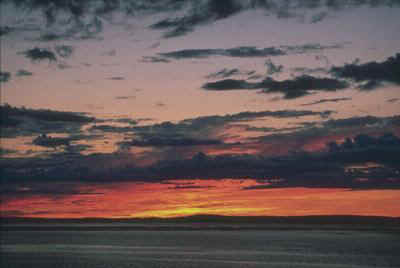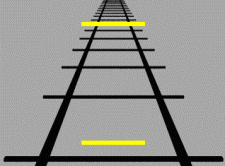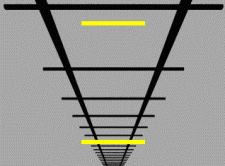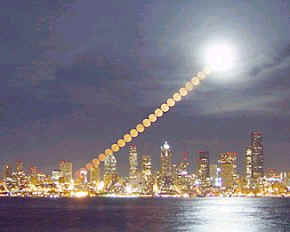SEEING A ROUND EARTH:
The Moon Illusion Explained
by Bill Lauritzen
I have wondered if there were ways that someone could experience the round Earth directly, besides going to high altitudes. In fact, I have wondered if perhaps the perception of a round Earth was natural, and that the flat Earth mind-set is learned though faulty language programming.
Perhaps through the use of the words "up" and "down" (which don't exist in a round world), through the use of a right-angled (x,y) coordinate system, through the use of flat maps, and through other subtle words and phrases in many different disciplines, we slowly lose our sensation of the round Earth, and in our mind we begin to perceive it as flat, despite all the NASA photos and video.
For example, in geology they talk of "plate tectonics," which makes you think that the "plates" that make up the earth's crust are flat, like plates. In actual fact, they are huge curved structures nothing like a plate, but more like an upside down bowl.
Maps actually cover these large bowls. Continents, nations, states, counties, and cities exist on upside down bowls. Oceans cover bowls. The Great Plains of the U.S. is actually a Great Bowl. Plateaus are not flat, but curved.
Another example is from the weatherman. He says that the wind "blows." We know, when we blow on our soup, that "blowing" occurs in a straight line. However, the wind is moving in anything but a straight line. If it did move in a straight line, it would very shortly be on its way to Mars. The wind "curves" gently from the northeast. Or it curves strongly from the southwest, etc. Using the word "curves" immediately summons up a view of the global dynamics of weather and gives one the immediate impression that weather is not a linear, flat-plane subject, and that it thus can not be predicted easily.
Other examples from meteorology: Hurricanes are actually not flat, but exist as huge domes of atmosphere. Low pressure systems and high pressure systems are both domes of air. Fronts exist as huge arcs. So the sky is a dome above us. The only fiction writer whom I have seen express this somewhat correctly was Thomas Wolfe. In one of his novels he mentions the "arc of the sky."
We might all be familiar with one particular method of perceiving the round Earth that particularly impressed me one day. If you live near the ocean, as I do, you can watch the ships come in to port. Near Long Beach Harbor, a very busy harbor by the way, I saw an interesting sight. Two large cargo ships identical in design were passing each other except that one was about five miles off the coast and the other was only a mile off the coast. The one that is further out was showing much less of her hull. At first, I though this was some sort of an optical illusion, but then I remembered that I, of course, was living on a round Earth, and I immediately felt a sort of sick feeling in my gut as I experienced it. It was frightening, yet wonderful.
I happened to have a portable telescope in my car, which I was able to focus on the two ships which had the effect of intensifying the experience. The ocean, for the first time, LOOKED curved
Since then, I have been trying to think of other ways to experience the round Earth. One particular method came to me which anyone can try, even if they don't live near an ocean or are not an astronaut.
The key is to watch clouds, particularly at "sunset" or spinout. (Of course, the sun doesn't set, the earth is merely spinning away from the sun hence my use of the word "spinout.") At this time, we often see layers of colorful clouds. The layers more distant are usually much smaller and much lower. However, we now know that cloud systems are generally at a certain altitude above the Earth. If you have ever been in an airliner or watched pictures from orbit then you have seen this.
So, the next time you experience this layered phenomenon just remember that these distant, "lower layers" are actually (in general) at the SAME altitude above the earth as are the nearer "layers." As you reorient your vision, you should experience the round Earth. The effect is definitely noticeable. Try it.
Even if you don't live near the ocean or on a large curved plain, I think you will notice that the clouds are in different positions than they would be than if the world were flat. Or, try it with this photo.

If one realizes that these clouds are all at about the same altitude then the Earth will begin to appear round.
In fact, I think this explains the so-called "moon illusion." This is the illusion that the moon looks larger near the horizon than when directly overhead. No one has really come up with an adequate explanation for this illusion, although many prominent scientists and thinkers have tried. Like many unsolved problems in science it is mis-named. It should be called the "Flat Earth Illusion."
Of course, one should also realize that there is no "horizon." There is no line separating the Earth from the sky, and if you walk toward it it always moves away. It is really a gradual dropping off as the Earth curves. It might be better to call it the "drop off curve-line."
If one sees the Earth as flat, when the moon is pictured against this flatness which must somehow extend off into infinity, it seems larger in comparison. If one re-educates their nervous system to see the Earth as round rather than flat (something I have found it possible to do, although it takes a little work), when one looks at the "drop off curve-line," one will no longer see the moon as larger at the horizon. In another article, " Spacehenge ," I write more about how to see the Earth as round by renaming the "sunset" the "spin-out." (We have known for 400 years that the sun does not set but that the Earth spins, yet our nervous system still sees the sun moving. You can also retrain your nervous system to see the correct "spin-out," rather than incorrect "sunset.")

Image credit: Tony Phillips
The Ponzo "Illusion," is a set of parallel tracks that converge in the distance. Two blocks of exactly the same size are inserted between the tracks. This "background" (in our case the flat Earth mind set) influences our perception of the "foreground" objects-the two blocks (in our case the moon). The farther of the two blocks appears significantly larger than its nearer companion. Dr. Carl J. Wenning says,
"The explanation of the Moon Illusion, then, is that it is nothing more than the Ponzo Illusion inverted!" This is not quite accurate. The Ponzo "Illusion" is not really an illusion. In the context of the 3-D information given to us, it is correct for our senses to infer that the top block is larger. To then switch and say it is really 2-D information is not fair.

The fact is that you can see a round Earth all the time. But there is a lot of denial about it. I am not sure why. It seems like our sensory system is calibrated against a flat Earth.
We don't have to be a slave to our antiquated language and oversimplified models. We can overcome them. We can see a round Earth. We can recalibrate our sensory system.

image credit: NASA
If one concentrates on the fact that the Earth is a round ball about 8,00 miles in diameter, and the moon is 250,000 miles away, then then the moon in this image appears the same size throughout the sequence.